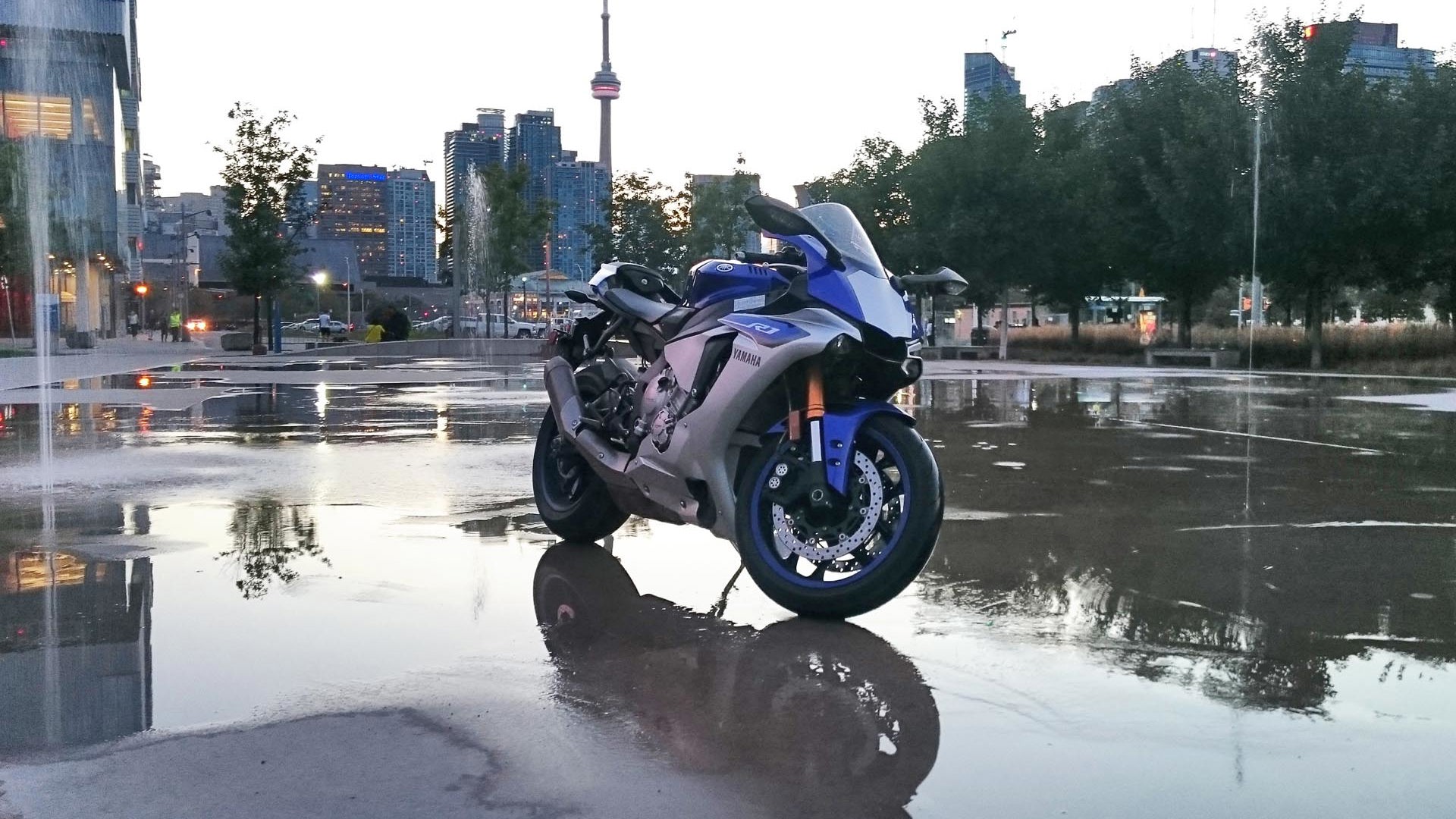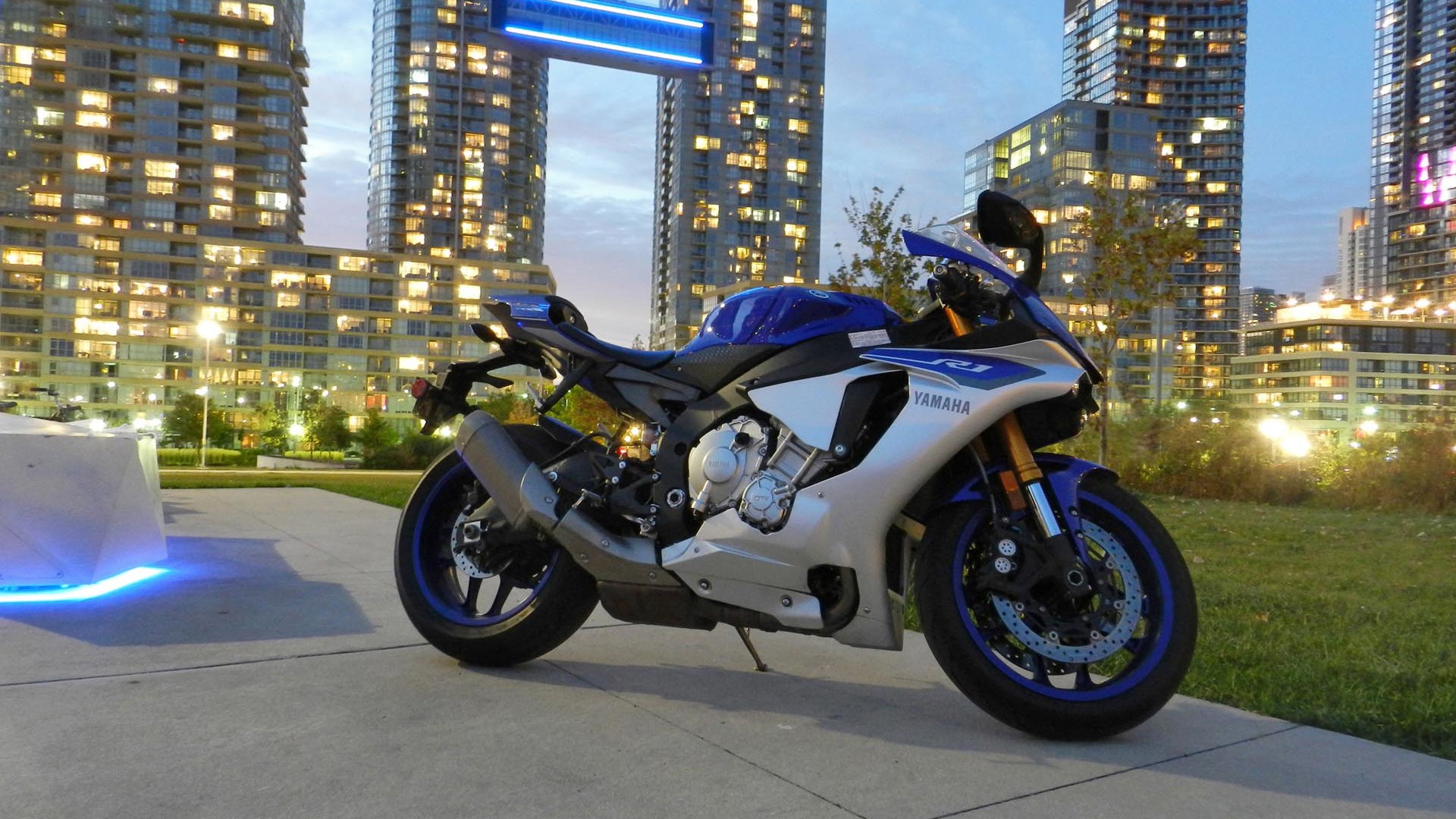The violence is astounding. The cross-plane crank gives the 2015 Yamaha YZF-R1 a brutality that can’t adequately be described – but when I flick my wrist and rip open the throttle for the first time the bike hurtles forward angrily, spinning up fast through the tall first gear and shaking its head the whole way towards the rapidly approaching stop sign.
Throwing out the anchors is no less gentle an experience and the lively chassis underneath feels like it’s quivering. Or was it me?
I should have seen it coming. Even from the moment I first slip the clutch and move out into the street the intimidation level is high. Out of habit I’d reached for the traction control settings button and then, wisely, withdrawn my thumb – not just yet.
I’m no stranger to litre bikes nor the Yamaha YZF R1. I owned a 2006 edition for a period. This is a different animal though, sharper, more compact somehow and with a face that reminds me too much of all the aliens in all the movies ever made. One misstep and she’ll eat me. Probably hunt down my family too.
Everything about this bike has been honed and refined past the point of insanity; at its core, the R1 is now a generation above the offerings of Honda and Suzuki and perhaps even BMW.

The clutch is definitive but the travel on the lever short, so the R1 lurches forward under me; impatient. I’m pootling around the carpark at low revs and I can feel the inline four’s growing frustration. The engine hunting, bike chomping at the bit. This is not a bike for commuting.
Not that you can’t, it’s more that the R1 doesn’t want you to.
More than any other litre bike the R1 feels compact and shrunken, my 5’6” frame felt like I was monstering the bike and the distance between my nose and the front of the bike was eerily short. You sit far forward with your elbows in tight and head down low. If there was any question as to the bike’s intent before you sat on it, it soon disappears.
The engine is gruff, the unique growl of a cross-plane crank is deep and disconcerting – like an old man barking his frustration at well, everything really.
The only real way to keep this Yammy happy is to take it to the track – something I sadly couldn’t do during my week with it – but which I intend to do another time. Yamaha being the good sports they are gave permission to track their bike, but the time period just didn’t let it work out.
Even on city streets, country roads and off-ramps the Yamaha lets its performance chops show.

Thanks in part to a 10 mm shorter wheelbase at 1,405 mm, tip-in is… um… rapid. Rapid enough for me to take a second bite at a couple of corners as I found myself cutting in closer than I expected. To change direction effectively you actually need to slow yourself down and smooth yourself out. “Out of the left, into the right, steady, move, hold” – oh wait, I’m already through the second corner.
The bike is at once angry and calm, it wants to go faster, but will accept your inputs unfalteringly. A common idiom in motorcycling is “look where you want to go”. It’s accurate more than ever here. The R1 feels two steps ahead of you at all turns.
The telepathic connection between you and the R1 requires you to make the right decision the first time. Like a good horse, the Yamaha rewards confidence and punishes indecision.
There’s more danger lurking too. At less than 200 kg wringing wet, and with more than 200 hp and 83 lb-ft of torque on tap the Yamaha will light up the 190/55ZR17 tire and introduce you to its little friend gravity before you can say “highside”.
At least it would, if not for the millions of worker bees feverishly punching numbers streaming in from the six-axis accelerometer and metering out precise amounts of that power and torque to the back wheel.

The Yamaha Ride Control system is perhaps more advanced than the system on the BMW S1000RR. It’s hard to explain, so allow me to consult the Yamaha literature:
“The Inertia Measurement features six axis of measurement using a gyro sensor to detect rotational motion in the pitch, roll and yaw directions. A "G" sensor detects acceleration / velocity in the forward and back, up and down and left and right directions. The vehicle position information obtained from the two sensors including bank angle, pitch rate and sideways slide acceleration is sent to the ECU which in turn controls the five YRC control systems (not including the quick shift system). These variables are calculated 125 times per second.”
And before you think, “Well, that sounds like a lot of nannies that are too complicated to work with,” allow me to interject.
The whole system is controlled by three buttons on the left grip that move you through four preset riding modes. If you want more control, you can dive into the menu by a long press of the scroll wheel on the right grip, and then set your own settings for each of the four riding modes. The settings are all displayed on the all-new TFT instrument cluster which is all-digital and business like. It’s a neat unit but I miss the aesthetic pleasure of an analogue tach.
All the enabled YRC systems are indicated in the top line of the dash so you know what is on and what is off at all times.

I took two days to figure out what LIF was. Spoiler: It’s a lift control system, AKA, anti-wheelie control. What does LIF do? It stops you throwing your front wheel up into the air in a move cops like to call, “Hahahaahahaha, I am impounding your stuff now, you moron!”
I found out what LIF was when I took it off for a moment. Then I put it back on. Honest, officer.
There are nine stages of traction control, three stages of lift and slide control, and even a full-throttle launch-control function – which I didn’t try because I need my license.
Slide control is one of the neatest tricks of Yamaha’s six-axis gyro, it will allow the braver of you to hold a consistent level of slide through corners as it reads lean angle, speed and throttle input and then carefully meters out the right amount of power to the back end. Never has drifting a bike out of a corner been so easy and safe to try. Which is in itself a scary thought.
The only thing I couldn’t do was completely turn off traction control (which was odd because “Off” was a visible option just not one I could move the cursor to). Oh, and I couldn’t turn off ABS, so I couldn’t do stoppies. Not that I would, of course.
An aside: better riders than I can do stoppies on an ABS-equipped bike. I cannot.
This bike also had permanently linked brakes, which Honda is actually moving away from, so I’m curious to see how consumers take to Yamaha’s system.
The quick-shifter makes short work of upshifts but doesn’t help with downshifts, leaving that mostly to the rider. A slipper clutch helps smooth out over-eager downshifts during braking however, keeping the back wheel in check until you want it to break loose.

At $18,999 that’s an insane amount of equipment to trickle down. For $22,999 you can get the even-more insane Yamaha R1M with a data logger and GPS-based lap timer (Communication Control Unit) and electric suspension control. But for my money the base model is the bargain deal, perhaps with the optional CCU.
However, no amount of electronic gadgets and high-tech wizardry can ever dull the legendary R1 character. It’s also forgiving thanks to the MotoGP-level technology that’s trickling down to the street.
Yamaha has managed to bless the R1 with more safety features and tech to keep you rubber side down in a way that doesn’t actually diminish the experience, but rather elevates it. Want to learn to feel a bike slide under you in a controlled environment? YRC can do that.
So yes, the computers do more than they used to, but don’t be lulled into a false sense of security.
The 2015 Yamaha YZF-R1 is still intimidating, angry and violent. Because that’s what it is supposed to be.

























